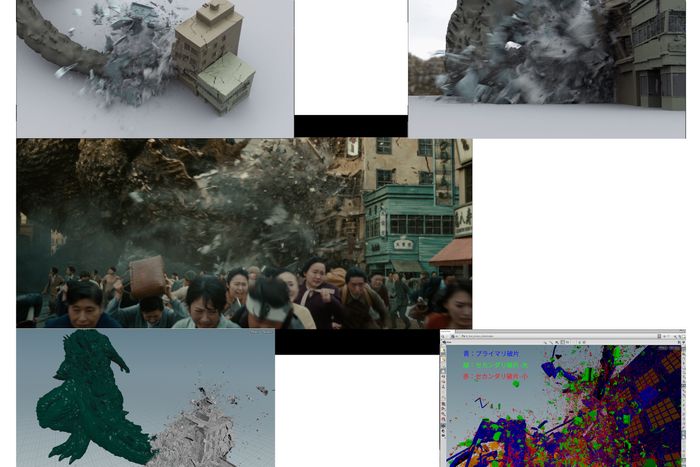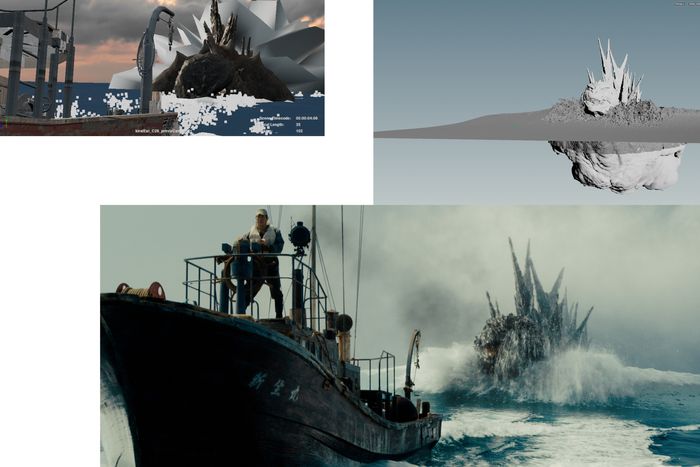
This article was originally published on February 6, 2024. At the 2024 Oscars, Godzilla Minus One won the award for Best Visual Effects.
As he often does in his films, Godzilla recently had a building full of people screaming. But rather than reeling in terror at the kaiju menace, Takashi Yamazaki and the rest of his team were celebrating. Godzilla Minus One had been nominated for an Academy Award for best visual effects — the first Oscars nod in Godzilla’s 70-year history and the first Japanese film to get such recognition, not counting 1971’s Tora! Tora! Tora!, which was an American co-production
“As a person who’s born in Japan, the Oscars — anything that’s in Hollywood, anything that’s in the West — is something that we feel like is just out of reach, unobtainable, and is not something that will happen. It will never come true,” Yamazaki, who oversaw Minus One’s visual effects in addition to writing and directing the film, told Vulture (with the help of a translator). “Maybe domestic awards, similar to the Oscars’ level. That would be a great goal to set.”
It was after the movie came out that Yamazaki, who got his start in the visual-effects world before becoming a major director, began to consider such a possibility. (Yamazaki has directed several Japanese blockbusters, and won Best Picture and Best Director twice at the Japan Academy Film Prize, the country’s Oscars equivalent.) Minus One, which has received wide critical praise and success in America and is the third-highest-grossing foreign-language film ever at the U.S. box office, takes place in postwar Japan as the King of the Monsters destroys a Tokyo that’s already in ruins. Demilitarized and varying degrees of demoralized, the civilians must band together to stop Godzilla, brought to imposing life by Yamazaki on a budget that’s hardly kaiju-size. The most recent American Godzilla movie, Godzilla vs. Kong, cost ten times as much as Minus One, and it was not nominated. (Yamazaki would only confirm that Minus One’s budget was within the $10 to $15 million range that has been previously reported, and he said he was unable to publicly specify how much of that was devoted to VFX.)
Feeling optimistic but hardly confident about Minus One’s chances after it was put on the shortlist of eligible films, Yamazaki compared watching the nominations announcements to the universal Japanese experience of waiting to see one’s high-school entrance-exam scores get posted.
“We had made it, and everyone was happy. We all drank until the early morning hours,” Yamazaki said. It was nighttime in Japan when the nominations were announced, and he’d gathered most of the VFX crew (and several Godzilla toys) in their Chofu, Tokyo, office for a party, complete with sushi. “And then the morning news started featuring the Oscars news. That’s the moment we were like, ‘Oh, it’s not a dream. It’s happening in real life.’” Over a video call from that same office, Yamazaki talked to us about how he and his team pulled off what no other Japanese movie — let alone one about Godzilla — has before.
I’ll just get right to it: How were you able to make Godzilla Minus One look this incredible on such a small budget?
This is the office. As you can see, I already have my staff members around me. They are all pretty much here. There’s no downtime or waiting time. On top of that, if I’m the director and also the VFX supervisor, I’m the one who has the vision in my head. It is very efficient because there’s no gap between what the director is thinking or asking for and the work that is being brought to me. The effectiveness of me being one mind and one body, and then having my staff around me, has helped accelerate the process of working together well.
In Japan, film budgets —and in particular when we talk about how much of a film budget is reserved for VFX — they’re not that large. So, we have been educated to work within the constraints of a small budget when it comes to VFX. For example, in terms of the destruction effect. We had worked on something called Godzilla: The Ride, which is in a theme park. We knew that there were some assets that we might be able to reuse or recycle, or perhaps we could use it as a reference. So we have ways that we come up with to save on costs to make it work.
Lastly, not just myself but all the members of my team knew that, if this is a Godzilla movie, it is not a domestic film. Some of the other work we do here is just intended for the domestic audience. But this is an international film. We have to meet those standards. Every person on the team did very well at keeping that in mind as they did their parts.
Marvel movies, for instance, use a lot of third-party VFX companies and they tend to waste time having to redo things. Are you saying that’s not what Minus One’s workflow was like?
Outsourcing to a third party is going to take time and money. We tend to keep it in-house. That’s just the most efficient and effective way to work. But that doesn’t mean we don’t have some external resources that we use. For example, the matte artists or miniature artists. We also have project-based freelance artists who have worked with us for many years. I would say, in this case, maybe one-third of the end-team-member count was freelance folks. We don’t always have 35 full-time employees in this office.
Being able to be on-site and interact with the artists right then and there and having that feedback loop is very effective for us. As I said earlier, when I’m the director and the supervisor and I have this vision in my head that is so solid, it eliminates the need for outsourcing and saying, “Oh, that’s not what we thought we were going to get.” It’s very solidified upfront. If we didn’t have that workflow, I think we would go in circles and go back and forth, and that’s when you end up wasting a little bit of time and money here and there.
There’s one thing that we use as a best practice, in-house. We call it the second-round or second-cycle rule. Think of it as if you’re a track-and-field athlete. The first loop, you just run as fast as you can. But on the second round, you want to improve. So we do the first round. Let’s do everything that we feel that we want to. Just get it in. Then we take a step back and look at that and say, “We can do better here,” or “Let’s correct here,” or “What about this?” Then we give the artist maybe about a month to do that in the second round. And that’s pretty much it, at that point. Of course, when you let artists loose they want to do so much, so we give that opportunity to them during the first round, but then during the second round we say “Okay, you have approximately a month to work on it.” That’s the approach that we take.
Vulture has done lots of reporting on working conditions in the American VFX industry. How are the conditions in Japan? I’ve read that they’re tough for animators — long hours and not especially high pay.
In Japan, we literally call a company “white” or “black.” “White” is a company that doesn’t exploit its employees and “black” is one that makes you work overnight at all hours and really doesn’t pay you well. Our studio name is Shirogumi (“white team”), so we want to believe we are setting up standards and an environment that is very workable for all the artists and everyone who is with us here today. As a creative myself but also an employer of creatives, I feel like what they make is so beautiful, and I hope and wish I would be able to pay our staff members better, at some point.
Sure, it might be challenging at times when we’re in a crunch or postproduction and need to get our work done. We try not to do late nights. We have all of our weekends off. A lot of us have families. A lot of us are also not at the age anymore where we can pull off all-nighters. So, we don’t let that happen. I also think that our teammates really work in harmony and they work very fast, very quickly. The output is great and that works to our advantage, that everyone is here working together.
One thing that I will say is that we had our company do a pretty nice renovation and overhaul of this office floor because once we knew that we were going to work on a Godzilla project, we knew that we were going to be spending significant hours together. We made it more comfortable and cozy; we spent some budget building out a kitchen. We have a designated sushi chef in the kitchen. We really try to avoid long hours, but if you do, it’s a very welcoming environment in which to spend a few extra hours. Hopefully, in due time, VFX budget increases will allow for more improvements. I am looking forward to the day when we can pay creatives more.
What was the hardest effect to pull off?
The hardest effect was dealing with a large amount of water and all the ships. It was just massive. The waves crashing through and the ships being destroyed. That eats up so much data and it’s so heavy that the systems in our office just could not tolerate and process it. That was really, really challenging.
Was there anything you wanted to do but couldn’t figure out how to make it work?
We feel like we were able to achieve what we wanted to do and set out to do. Knowing from the start that, yes, there’s a budget constraint, we knew what we thought we could do, and so we were able to do it — including the massive sort of movement and the battles in the water. We were able to pull it off. That is not to say, if there is ever a sequel, that maybe there aren’t some things that I would want to work on. But within the framework of what we set out to do, I feel like we were able to accomplish it all.
What could Hollywood blockbusters learn from Godzilla Minus One’s success?
I don’t even know if I’m in a position to say. We have learned so much from Hollywood that I don’t know if there is anything in return that Hollywood can learn from us. If I were to maybe point out one thing — without really having any concrete basis to back this up — it’s that if there is a solid vision throughout the process of making a single film, then I think there is a way to cut down on costs. Yes, there are trial-and-error costs, and bouncing ideas off each other is necessary to a certain extent. But, if you can clearly communicate that vision, then maybe there is no need to do a lot of experimenting on the side that eats up a lot of cost and time. Perhaps that’s it, but I don’t think that’s anything that Hollywood would be learning from us.



